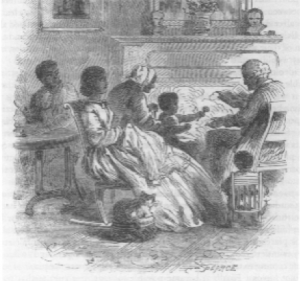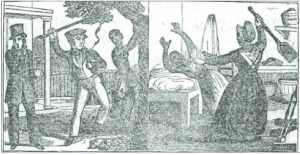Women and men are different. At least that what the thought was in early America. During this time, as women started to seek out their own self-worth, there came a separation between them and men. This separation was not just caused by women alone. Many other factors were in play. How the economy was changing was a big factor. In both “Pedestal, Loom, and Auction Block” by Ellen Carol DuBois and Lynn Dumenil and “Separate Spheres, Female Worlds, Woman’s Place: The Rhetoric of Women’s History” by Linda Kerber the idea of the separation is really examined.
DuBois and Dumenil believe that the separation of women from men can be seen through the idea of “true womanhood.” According to DuBois and Dumenil, true womanhood came from motherhood.[1] Women were seen as more nurturing and caring than men were. Right away, we get to see the separation between the two groups. This idea was not just for women to be able to recognize what they should be doing. This idea was also set in classist thinking. In “Pedestal, Loom, and Auction Block,” the authors say how middle class women used this idea to look down and separate themselves from women who weren’t as well off.[2] However, this idea of true womanhood was greatly tested. This test came from the change to market economy in the United States. There was a great shift from people making goods in their own homes and working for themselves to going to work for someone else in a factory. There was no better evidence than the “Lowell girls,” the unmarried and mostly teenage girls who worked at a textile factory in Lowell, Massachusetts.[3] By working these girls felt like they got a little independence.
Kerber writes about many of the same ideas that DuBois and Dumenil cover. Two of the major ideas both readings discuss is the separation of spheres between men and women, and the economy and it that changed the dynamic. Women were put into the role of the domestic sphere which revolved around their home life.[4] Kerber also writes about the Industrial Revolution and how it affected the way of life for both men and women. Women began to leave their homes to work in factories. Just as Dubois and Dumenil mentioned, middle class women used this to look down upon women, who they thought were beneath them. They used the slogan “woman’s place is in the home.”[5] They used this to say that the women going out to work in these factories were not real women. This image is a great representation of what woman’s life should be, which was domestic and all about the home.[6] 
However, one reading may be better than another. Dubois and Dumenil cover enslaved women. They made a connection that the spheres of separation, especially in the work area, were not in play for enslave women. Enslaved women, along with the men, had to plant and pick the cotton all day long.[7] As the picture indicates, enslaved women were also beaten just like enslaved men.[8] This just further proves that there was little separation of labor within among the enslaved.
Both of these readings tell us about how there were a separation of spheres between men and women. They also talk about why this separation came about and the things that were harmful towards this separation. Unfortunately, just like a lot of historical records, many records of minorities and people not in power were not the focus.
[1] DuBois and Dumenil, 188
[2] Ibid, 192
[3] Ibid, 197
[4] Kerber, 10
[5] Ibid, 12
[6] Ibid, 25
[7] DuBois and Dumenil, 211
[8] Ibid, 215
